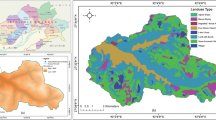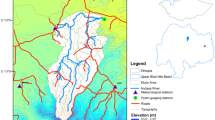Abstract
The Elbow River watershed, located in the rain shadow of the Rocky Mountains in western Canada, is characterized by a complex hydrological regime due to significant differences in climate and geomorphological settings between the west and east sub-catchments. This watershed has experienced several extreme droughts and floods in the recent decades, which might be accentuated with climate change. This study was undertaken to investigate the average annual and seasonal variations of surface and sub-surface hydrological processes in the west and east sub-catchments along with and the entire watershed under five plausible GCM-scenarios up to 2070 using the physically-based, distributed MIKE SHE/MIKE 11 model. Most of the scenarios indicate a reduction in the average annual overland flow, groundwater recharge and baseflow in the east sub-catchment. The pattern of seasonal change generally exhibits a rise in overland flow, baseflow, evapotranspiration, groundwater recharge, and streamflow in winter-spring and a decline in summer-fall. The induced changes in hydrological processes are proportionally more perceptible in the east sub-catchment compared to the west sub-catchment. However, the west sub-catchment governs the watershed behaviour and determines the future changes, over-riding the stronger climate change signal in the east. This investigation indicates that a greater understanding of climate change impacts on the water balance of a watershed with significant differences in sub-regional settings is achieved when capturing the surface and subsurface hydrological process responses of each sub-catchment individually along with the entire watershed. Such information can guide water resources management by providing a more rigorous assessment of the processes involved in the watershed.





Similar content being viewed by others
Notes
Data from the IPCC Third Assessment Report (TAR) GCM simulations were used in this study to allow comparisons with previous studies done by Alberta Environment and Parks. However, in future work, we recommend applying IPCC Fourth/Fifth Assessment Report (AR4/AR5).
The names of the scenarios are not attached with their corresponding GCMs for simplicity and fluidity reasons.
Groundwater recharge may not have even a linear relationship with infiltration when the infiltrated water into the soil can be taken up by the plant roots and consequently transpired.
References
Al-Mukhtar M, Dunger V, Merkel B (2014) Assessing the impacts of climate change on hydrology of the upper reach of the spree river: Germany. Water Resour Manag 28(10):2731–2749
Barrow E, Yu G (2005) Climate scenarios for Alberta. Report prepared for the Prairie Adaptation Research Collaborative (PARC) in co-operation with Alberta environment, pp. 1–73
Chang H, Jung IW (2010) Spatial and temporal changes in runoff caused by climate change in a complex large river basin in Oregon. J Hydrol 388(3):186–207
Espadafor M, Lorite IJ, Gavilán P, Berengena J (2011) An analysis of the tendency of reference evapotranspiration estimates and other climate variables during the last 45 years in Southern Spain. Agric Water Manag 98(6):1045–1061
Farjad B, Gupta A, Marceau DJ (2015) Hydrological regime responses to climate change for the 2020s and 2050s periods in the Elbow River watershed in southern Alberta, Canada. In: Ramkumar M, Kumarasamy K, Mohanraj R (eds) Environmental management of river basin ecosystems. Springer International Publishing, Switzerland, pp 65–89
Fiseha BM, Setegn SG, Melesse AM, Volpi E, Fiori A (2014) Impact of climate change on the hydrology of upper Tiber River Basin using bias corrected regional climate model. Water Resour Manag 28(5):1327–1343
Frost RE, Woods KB (1948) Airphoto patterns of soils of the Western United States (No. TR-85). Department of Commerce Civil Aeronautics Administration, US
Gan TY (2000) Reducing vulnerability of water resources of Canadian prairies to potential droughts and possible climatic warming. Water Resour Manag 14(2):111–135
Gan TY, Burges SJ (1990) An assessment of a conceptual rainfall‐runoff model’s ability to represent the dynamics of small hypothetical catchments: 2. Hydrologic responses for normal and extreme rainfall. Water Resour Res 26(7):1605–1619
GeoBase (2008) Geospatial data overseen by the Canadian Council on Geomatics (CCOG). http://www.geobase.ca/
Göncü S, Albek E (2010) Modeling climate change effects on streams and reservoirs with HSPF. Water Resour Manag 24(4):707–726
Hargreaves GH, Samani ZA (1985) Reference crop evapotranspiration from ambient air temperature. Am Soc Agric Eng 1(2):96–99
Hay LE, McCabe GJ (2010) Hydrologic effects of climate change in the Yukon River Basin. Clim Chang 100(3-4):509–523
IPCC (2014) Climate change 2014: impacts, adaptation, and vulnerability. Fifth assessment report (AR5): Intergovernmental Panel on Climate Change (IPCC), Working Group II
Kristensen, Jensen (1975) A model for estimating actual evapotranspiration from potential evapotranspiration. Nord Hydrol 6:170–188
Ludwig R, May I, Turcotte R, Vescovi L, Braun M, Cyr JF, Fortin LG, Chaumont D, Biner S, Chartier I, Caya D, Mauser W (2009) The role of hydrological model complexity and uncertainty in climate change impact assessment. Adv Geosci 21(21):63–71
Minville M, Brissette F, Leconte R (2008) Uncertainty of the impact of climate change on the hydrology of a nordic watershed. J Hydrol 358(1):70–83
Priestley CHB, Taylor RJ (1972) On the assessment of surface heat flux and evaporation using large-scale parameters. Mon Weather Rev 100(2):81–92
Prudhomme C, Reynard N, Crooks S (2002) Downscaling of global climate models for flood frequency analysis: where are we now? Hydrol Process 16(6):1137–1150
Sentelhas PC, Gillespie TJ, Santos EA (2010) Evaluation of FAO Penman–Monteith and alternative methods for estimating reference evapotranspiration with missing data in Southern Ontario, Canada. Agric Water Manag 97(5):635–644
Uniyal B, Jha MK, Verma AK (2015) Assessing climate change impact on water balance components of a river basin using SWAT model. Water Resour Manag 29(13):4767–4785
Whitfield PH, Cannon AJ (2000) Recent variations in climate and hydrology in Canada. Can Water Resour J 25(1):19–65
Wijesekara GN, Farjad B, Gupta A, Qiao Y, Delaney P, Marceau DJ (2014) A comprehensive land-use/hydrological modeling system for scenario simulations in the Elbow River watershed, Alberta, Canada. Environ Manag 53(2):357–381
World water development report (WWDR4) (2012) Managing water under uncertainty and risk. The United Nations World Water Development Report 4, Volume 1, Sixth World Water Forum, Marseille, France, March 12–16
Zhang H, Huang G H, Wang D, Zhang X (2011) Uncertainty assessment of climate change impacts on the hydrology of small prairie wetlands. J Hydrol 396(1):94–103
Acknowledgments
This project was funded by a grant awarded to D. Marceau by Tecterra and Alberta Environment and Parks (AEP), and by a scholarship awarded to B. Farjad by Alberta Innovates Technology Futures. We thank Dr. Shawn Marshall from the Department of Geography at the University of Calgary for his careful reviews and constructive suggestions. We also thank insightful discussions with Patrick Delaney and Ying Qiao from DHI Water and Environment Canada.
Author information
Authors and Affiliations
Corresponding author
Rights and permissions
About this article
Cite this article
Farjad, B., Gupta, A. & Marceau, D.J. Annual and Seasonal Variations of Hydrological Processes Under Climate Change Scenarios in Two Sub-Catchments of a Complex Watershed. Water Resour Manage 30, 2851–2865 (2016). https://doi.org/10.1007/s11269-016-1329-3
Received:
Accepted:
Published:
Issue Date:
DOI: https://doi.org/10.1007/s11269-016-1329-3




